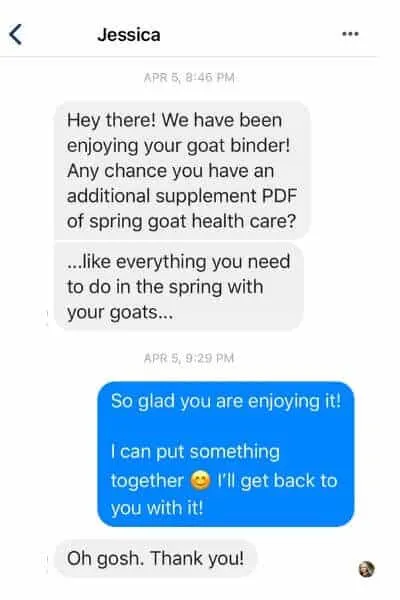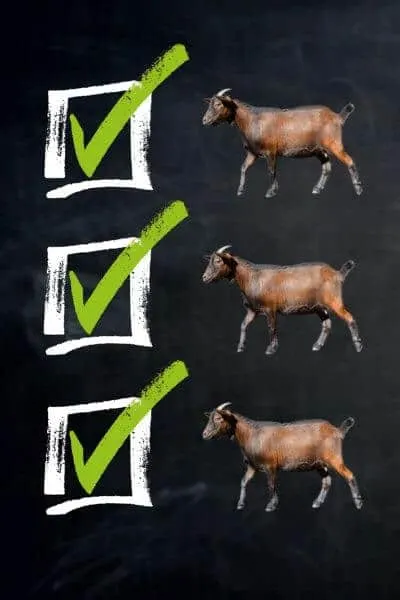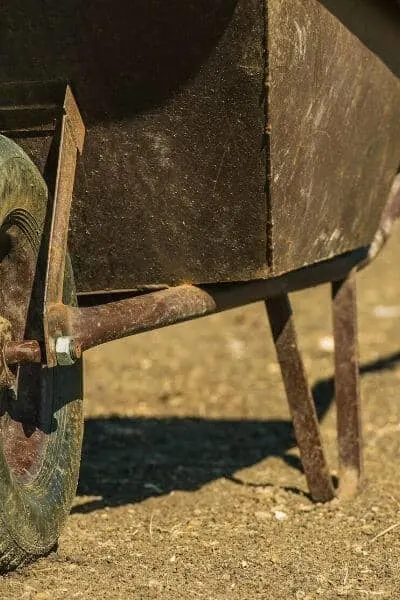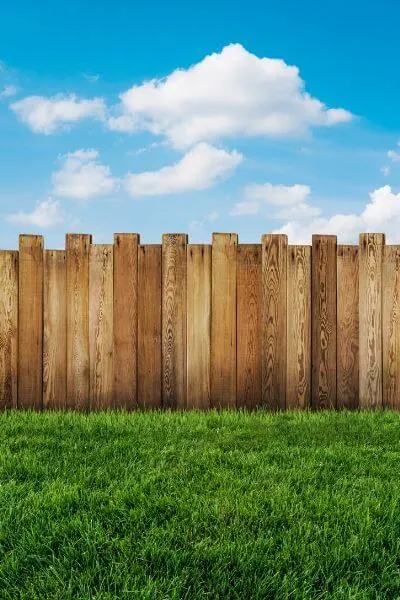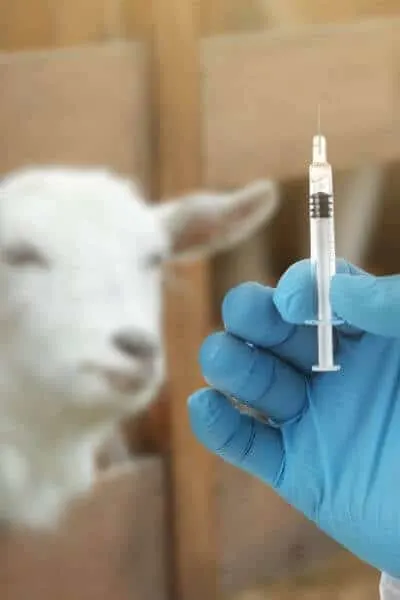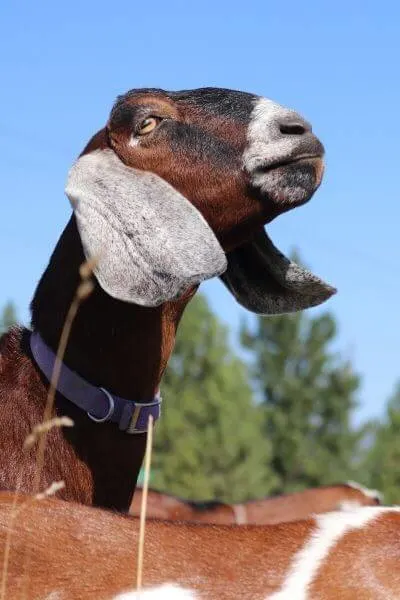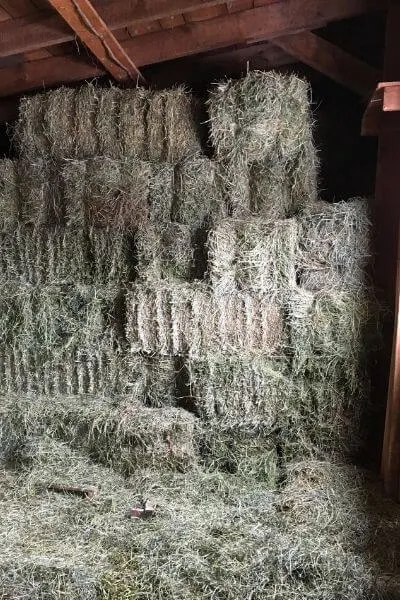Spring is my most favorite time of year. The winters in Montana have usually been long and by spring, winter is somewhat torturesome. Because up North it still acts like winter after it’s officially spring. So when spring comes along, we’re all eager to get our checklists out, get outside and DO something wonderful! And one of the first lists to pull out and dust off is the spring goat checklist.
I was recently asked this question…
It will be hard to distinguish when the precise date should be set for any of this information I’ll be sharing because of the biggest variable: weather. So let’s just establish that as the weather is getting warmer, the snow is lessening, when spring has officially begun, and before your goats are having their kids, this is when you will begin your spring goat checklist.
Winter can be hard on goats. Less space to roam, less fresh vegetation, and usually a doe is getting larger in pregnancy during this time and all of that will take its toll on your goat’s health. And if you’re breeding your goats, then you need healthy does and healthy kids. And, of course, if you just love your goats, you will want to give them your all and help them live a happy and healthy life.
And this list will help you accomplish just that!
Ok. So where do you begin? I’m going to split this up into two categories: goat surroundings and the goats themselves. And towards the end, when we’re talking about your goat’s health I’ll go into supplements and vaccines you can give your goats in the spring.
In all of my videos and articles, I go into as deep of detail as I can. I’m not going to shorten what I share just to make it a short article or video. So take a seat, and enjoy! After you watch this you’ll want to click over to my raising goats playlist and partake in a lot more goat information.
I’ve also created a spring “get-er-done” checklist and a goat health evaluation checklist and added it to the bonuses in My Goat Binder. So if you’ve already gotten that, then be sure to log in and get it printed out.
Let’s start with the general task of cleaning up the winter mess. Now, I’m not saying you’re messy but there’s just something about winter with the cold and snow that doesn’t help in keeping things neat and tidy.
Everything seems to pile up: the bedding, the mud, and all the weak points. The milking barn may have been unused and it’s amazing how it can get cluttered and dirty.
So Let’s Begin Your Spring Goat Checklist
Goat Surroundings
We all have different setups so this won’t all be the same and there might need to be some adjustments.
Clean the Shelters
Goat shelters can get a large pile and build-up of bedding. It will break down over time and can be a great addition to your garden. But it’s really good to get these cleaned out as soon as possible so that it doesn’t sit and rot the flooring or the sides of the shelter. Neither my barn or my pallet goat shelters have any flooring underneath but the build-up of bedding could still rot the sides of the pallets.
So what I’ll do is get these all cleaned out and then they’ll be ready to use in the winter. When the weather warms up and the ground is dry, my goats prefer to sleep outside, so I won’t put any bedding inside these shelters until winter.
And our barn is also used to store hay. So cleaning our big barn out will not only get it ready for the kidding season but will also get it ready for the haying season which will start this summer.
And if you’re not convinced to clean out your barns and shelters yet, then you may want to watch the videos linked below on my channel about lice in goats. Cleaning out the shelters and dusting the area with diatomaceous earth will stop the life cycle of lice.
You can learn more about lice in these articles and videos: Lice in Goats Article. And these videos will help you as well: Natural Treatments for Lice in Goats (Video) and Chemical Treatments for Lice in Goats (Video)
So that’s it for shelters. Get them cleaned and disinfected.
Clean Up the Pen Area
The outside pen area can also build up a lot of “bedding”, aka all the hay they wasted all winter long. And if that wasted hay isn’t cleaned up, you will have your goats playing king of the mountain on your new landscape. New large hills will develop on your property.
I have started feeding my goats their hay in what we call the “hayfield”. Before my goats, we would hay this field but now we allow them to browse this in the spring and summer months instead of haying it. So feeding them hay in this pasture will just add organic matter when they waste the hay. So I spread it out each time so it doesn’t pile up.
We also fed a round bale to them this winter and one thing I’ll have to do as early as possible is spread out the larger pile they left behind. If I don’t do that, it will kill the grass underneath.
Clean and Disinfect Water Troughs
It’s always good to get all the slim or moss or green stuff that may have started growing in their water troughs cleaned up and disinfected. I have a birdhouse above my water trough and I need to add something to the top of the waterer before it gets active this spring. There’s always a family of birds that hatch out a few eggs each spring and they poop in the water!
And I have to engineer a way to keep the ducks out of the trough as well. Oh, ducks. Ducks! How I love you and hate you. They will make a mess of your clean water faster than you can say, “Duck!”
You can rinse out the tank, drop in some dish soap and then using a scrub brush, clean out all the corners and sides and then rinse it thoroughly after.
If you’ve never thought about it, watch this video about how your water could be affecting your goat’s health: Your Water Could Be Affecting Your Goat’s Health
Fix Shelters, Fences, and Broken Items
As soon as the ground unfreezes, we’ll start replacing the goat pen fence and will just need to dig post holes. So that’s on the docket this spring. And the goat gate isn’t looking very good. Last summer, we had a mare and her foal want into the pen to eat the hay in the feeder instead of the grass in the field and she got it all knocked down and then stepped on it and broke it all up. So this is an example of something needing to be fixed because it is obviously broken.
Because the goats run and jump like crazy up onto the stand above the mineral feeders, they have sheared off the screws and these need to be fastened down and I plan to put a plywood board with some old roofing that wasn’t used in a project long ago.
The roof on one of the pallet goat shelters finally blew off. It was already old and used roofing that we reused here and after 5 years it finally had enough.
And spring is also the best time to fix or redo things to work better in the winter months. These shelters need to be reworked a bit to have a better windbreak on the front side. Believe me, right out of spring you know what didn’t work and what did during the winter months and if done early enough, you can get this stuff done before the crazy garden season starts and done before the next winter cycle.
See? Always lots of things to work on and make better. Although the examples I’ve shared are what I need to do, you’ll have your own list that will keep growing.
Clean, straighten and prepare the milking room
I’m not currently milking right now. I keep moving my breeding season to a bit later because we always get spring snowstorms and really cold weather and it always happens (if at all possible!) that a goat is kidding in the dark and cold of a snowstorm.
But I want to do some work in my milking area this year to make it work better. So in your milking area, get it cleaned up, cleaned out, organized and just to your liking.
And doing this when you aren’t in the middle of milking will help keep you sane.
After you’ve gone through all of that, it’s time to really take a look at your goat’s health. How are your goats coming out of the winter months? Are they healthy? Or do they need a little boost?
Double Check Your Goat Medications
Get all your medications all cleaned up and make sure you aren’t low on certain items. Get your medication checklist out and check what you do and don’t have and what you should get for the year. Remember, a goat doesn’t care if it’s Saturday night at 9:00. They get sick when they get sick. And it is so much better to have everything on hand than to be searching for it when it’s harder to find.
Goat Health Evaluation
That was a lot of clean up and planning I just mentioned. But now, let’s look at your goats themselves.
When looking at your goat’s what do you need to be seeing? What do you need to be looking for?
Evaluate your Goat’s Health
Start with the most obvious and easiest place to start: their hair coat.
Is their hair coat:
- Shiny and glossy
- Original color (not fading or changing color)
- Free from dandruff or skin issues
- Free from lice or other parasites
- Tail heads should be full of hair and not bald or “fish-tailed”
After evaluating their hair, check their eyelids.
Are their eyelids:
- Bright pink
If you don’t know about the dangers of anemia, please take this free mini-course: Anemia in Goats
After you check their eyelids, move onto their body condition.
Optimally a goat should have:
- The area between pin bones is smoothed out
- Ends of short ribs can be felt with moderate pressure
- Slight depression visible in the loin area
- Hips and pin bones can be felt but have some covering of flesh
- The back has lost angularity and appears smooth
In general, a goat should not look too skinny or too fat. They should look healthy and full of vitality.
Next up…take note of their poop.
The poop should be:
- Individual, round “marbles”
- Not clumped or loose in any way
Now, take a look at their feet.
Their feet should be:
- Not overgrown or growing under
- Not too long in the front
Ok? Got that all evaluated? I’ve added a bonus to My Goat Binder where you can evaluate your goat and write down the information. It has this complete Spring Checklist all ready to be printed out. So if you’ve gotten this binder already, log in and get it printed out.
Evaluate your Feeding Program
If your goats are looking a little worse for wear, then you need to evaluate your feeding program. When your goats are healthy, they are much more able to resist disease, worms, sickness, and general unthriftiness.
Please take some time to watch this video: What Do Goats Eat? or Article: What Do Goats Eat?
Make double sure that you are offering your goats minerals at all times. Learn more: Goat Mineral Guidelines Video or Article: Goat Mineral Guidelines
Evaluate Your Supplements
If your goats just can’t get the necessary nutrients from the food you give or even the minerals, then you will need to supplement with other things.
If you know your area is deficient in copper and you’ve been giving copper but your goats may still be showing signs that they are still needing copper, decide now to add one more dose of copper a year. And then evaluate again as the year progresses.
For instance, if you are now giving one dose of copper, then start giving two 6 months apart.
You can learn more about copper here: Copper Guidelines, Can Copper be Given to Pregnant Goats?, How Often to Give Copper to Goats?
Yearly Vaccinations
If you give any of these vaccinations I’m about to mention, then you will put them on your calendar, write them in your goat binder and give them once a year.
The CD&T vaccine will be given once a year but if you have pregnant does, then you will give this 4 weeks before their due date. You can read more about that here: CDT Vaccine for Goats or watch the information: CDT Vaccine for Goats Video
If you know that your area and your goats are selenium deficient, then you would give a BoSe Shot. BUT selenium can overdose very easily, so please, please be careful with this one. But if you know your goats need this, then you can give it in the spring and give your pregnant does some 4-6 weeks before kidding. Depending on your area, you may also give the Bose shot in the fall as well.
You can also give the pneumonia vaccine in the spring as well. Read more about pneumonia here: Pneumonia in Goats or watch the video here: Leading Killer in Goats: Pneumonia
Put all of these in your calendar and be sure to document them in your goat binder.
Worming Your Goats
Worms have a very strategic lifecycle. Their sole purpose is to survive and produce offspring. Worms can and will wreak havoc in your goat herd if you don’t stay on top of them. Goats can pick up the eggs and the process of them wrecking your goat can start immediately or they can go into dormancy throughout the winter if they are picked up in the fall.
And when is the environment just perfect for them to wake up and start ruining things? Right after a goat gives birth. A week before your does give birth, check your goat’s poop for signs of worms. If they have worms, you’ll want to worm your does 1 week before their due date. And then 10 days after, worm again.
Worming your goats can’t be put on a schedule, however. You will only worm your goats when they NEED to be wormed. But check your goat’s fecals in the spring and then proceed from there. If they need to be wormed, worm them. If not, don’t. And don’t ever do a blanket worming of all your goats in the herd. This only leads to worms becoming resistant to the wormers we’re using. And it is documented that some wormers have already become resistant to some types of womers already.
Man, if you don’t think that’s quite the list, then you are an overachiever! Just kidding. But really, there is a lot to do as we all awaken from our winter slumber.
But it’s really important to think through all of this so that you have a healthy herd going into the rest of the year. It will be worth the effort and when winter begins, you will be so glad you put in the work already and that it’s ready for your goats and you to enjoy instead of stressing over.
Thanks for spending this time with me! My name is Delci from A Life of Heritage. Now it’s time for all of us to get our spring checklists printed out because we all have a lot of work to do!
